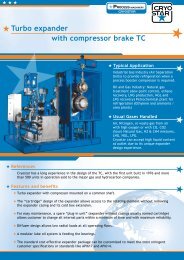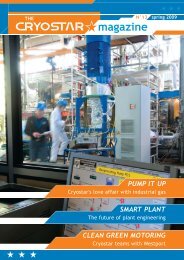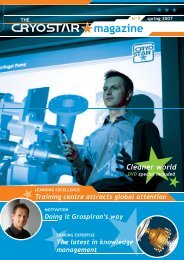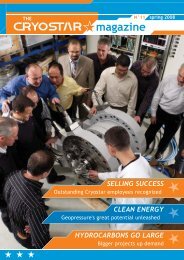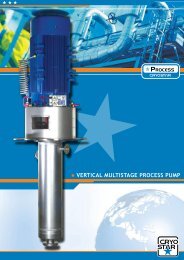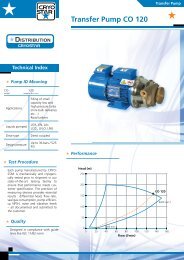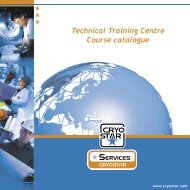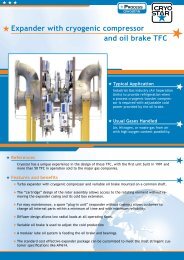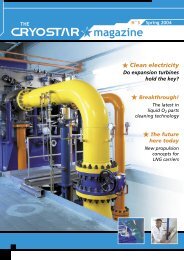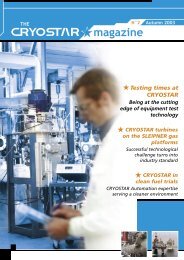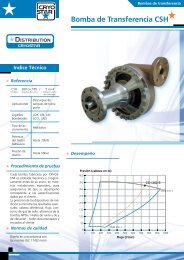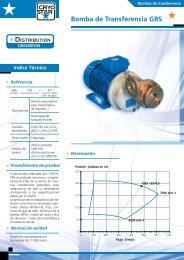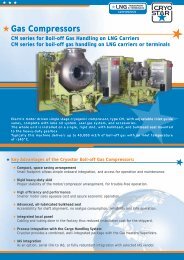The Cryostar Magazine N°10 : pdf file
The Cryostar Magazine N°10 : pdf file
The Cryostar Magazine N°10 : pdf file
You also want an ePaper? Increase the reach of your titles
YUMPU automatically turns print PDFs into web optimized ePapers that Google loves.
HOW IT WORKS<br />
EcoRel, how it works<br />
Thanks to its low power consumption, the <strong>Cryostar</strong> EcoRel Boil Off Gas (BOG)<br />
re-liquefaction system has been selected to equip the largest ever built Q-Max series<br />
LNG carriers (14 vessels on order already).<br />
<strong>The</strong> concept of EcoRel is to be economical but also user-friendly and safe for the<br />
environment.<br />
It performs full re-liquefaction of the BOG. <strong>Cryostar</strong> has designed the process as well<br />
as the machines. This guarantees the best possible match between the process and the<br />
rotating equipment.<br />
History of LNG carrier propulsion<br />
Natural gas is transported over long distances<br />
in liquid form, at ambient atmospheric pressure,<br />
near its boiling point (-163°C) in insulated tanks<br />
onboard LNG carriers. Due to unavoidable heat<br />
inleak during the voyage, a portion of the cargo<br />
vaporizes, equivalent to about 3 % of the total<br />
volume over 20 days. In order to maintain the<br />
tank pressure close to atmospheric pressure the<br />
vapor generated by this vaporization must be<br />
removed from the tank.<br />
Historically, so as not to waste it, the BOG was<br />
burned in boilers to produce steam for the ship’s<br />
propulsion. Until very recently all LNG carriers<br />
relied on steam turbines for their propulsion and<br />
are the last vessels built with this type of propulsion.<br />
However, in recent times, the evolution<br />
of fuel costs, and the lack of crew with steam<br />
propulsion experience, has promoted innovation<br />
in the conservative LNG carrier world.<br />
Two new propulsion systems are now being<br />
implemented in addition to steam turbine<br />
propulsion. Other propulsion systems, like gas<br />
turbine or 250 bar gas injection, are still under<br />
investigation.<br />
One of the two new concepts was the Dual Fuel<br />
Diesel Electric (DFDE) system. It burns the BOG<br />
(at ~ 6 bar) in dual fuel diesel engines (gas or<br />
diesel oil). <strong>The</strong>se engines drive generators to<br />
produce electricity for the electric motors driving<br />
the ship. <strong>Cryostar</strong> collaborated actively with<br />
shipbuilders in the development of the gas handling<br />
system for these vessels and has supplied<br />
the compressors for all delivered DFDE LNG<br />
carriers.<br />
<strong>The</strong> other concept, subject of this article, completely<br />
splits cargo handling from the propulsion<br />
of the vessel. It maintains the cargo pressure and<br />
inventory by re-liquefying the BOG generated<br />
in the tanks and relies on cheaper heavy fuel oil<br />
(HFO) for the ship’s propulsion using slow speed<br />
diesel engines.<br />
Following an intensive 15-month testing process<br />
by Exxon-Mobil, the <strong>Cryostar</strong> re-liquefaction<br />
system EcoRel has been selected for the largest<br />
ever built Q-Max series LNG carriers. <strong>The</strong> capacity<br />
of these vessels, 265 000 m3, exceeds by<br />
far all that of all other LNG vessels ever built.<br />
Autumn 2007 3



